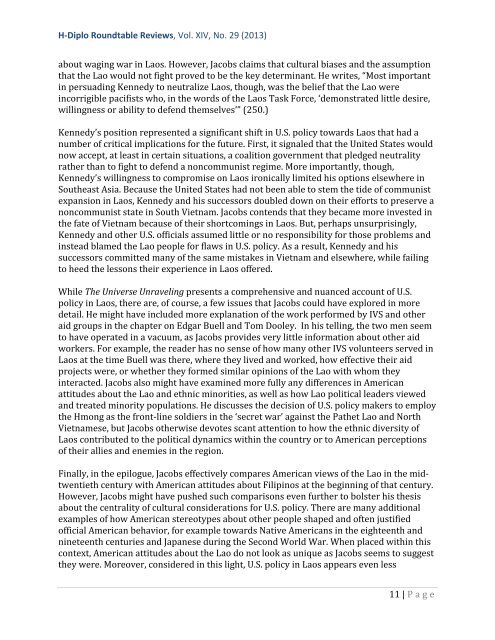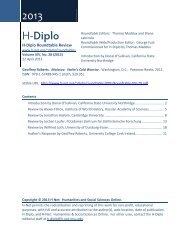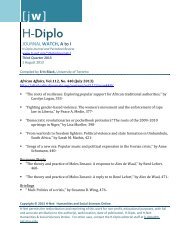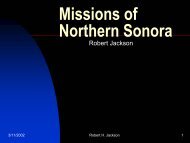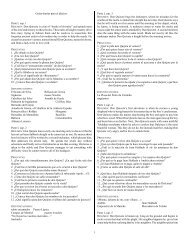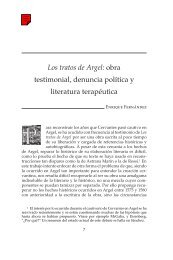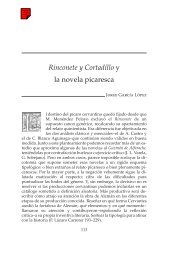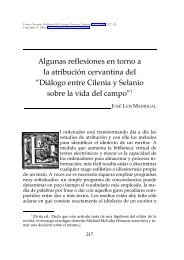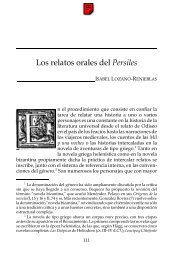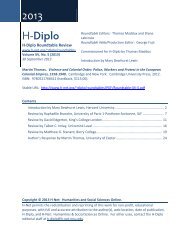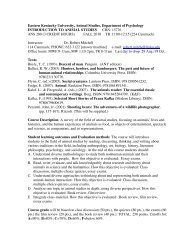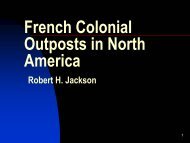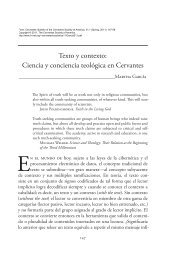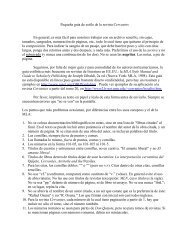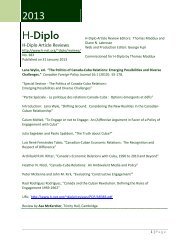H-Diplo Roundtables, Vol. XIV, No. 29 (2013) - H-Net
H-Diplo Roundtables, Vol. XIV, No. 29 (2013) - H-Net
H-Diplo Roundtables, Vol. XIV, No. 29 (2013) - H-Net
You also want an ePaper? Increase the reach of your titles
YUMPU automatically turns print PDFs into web optimized ePapers that Google loves.
H-<strong>Diplo</strong> Roundtable Reviews, <strong>Vol</strong>. <strong>XIV</strong>, <strong>No</strong>. <strong>29</strong> (<strong>2013</strong>)<br />
about waging war in Laos. However, Jacobs claims that cultural biases and the assumption<br />
that the Lao would not fight proved to be the key determinant. He writes, “Most important<br />
in persuading Kennedy to neutralize Laos, though, was the belief that the Lao were<br />
incorrigible pacifists who, in the words of the Laos Task Force, ‘demonstrated little desire,<br />
willingness or ability to defend themselves’” (250.)<br />
Kennedy’s position represented a significant shift in U.S. policy towards Laos that had a<br />
number of critical implications for the future. First, it signaled that the United States would<br />
now accept, at least in certain situations, a coalition government that pledged neutrality<br />
rather than to fight to defend a noncommunist regime. More importantly, though,<br />
Kennedy’s willingness to compromise on Laos ironically limited his options elsewhere in<br />
Southeast Asia. Because the United States had not been able to stem the tide of communist<br />
expansion in Laos, Kennedy and his successors doubled down on their efforts to preserve a<br />
noncommunist state in South Vietnam. Jacobs contends that they became more invested in<br />
the fate of Vietnam because of their shortcomings in Laos. But, perhaps unsurprisingly,<br />
Kennedy and other U.S. officials assumed little or no responsibility for those problems and<br />
instead blamed the Lao people for flaws in U.S. policy. As a result, Kennedy and his<br />
successors committed many of the same mistakes in Vietnam and elsewhere, while failing<br />
to heed the lessons their experience in Laos offered.<br />
While The Universe Unraveling presents a comprehensive and nuanced account of U.S.<br />
policy in Laos, there are, of course, a few issues that Jacobs could have explored in more<br />
detail. He might have included more explanation of the work performed by IVS and other<br />
aid groups in the chapter on Edgar Buell and Tom Dooley. In his telling, the two men seem<br />
to have operated in a vacuum, as Jacobs provides very little information about other aid<br />
workers. For example, the reader has no sense of how many other IVS volunteers served in<br />
Laos at the time Buell was there, where they lived and worked, how effective their aid<br />
projects were, or whether they formed similar opinions of the Lao with whom they<br />
interacted. Jacobs also might have examined more fully any differences in American<br />
attitudes about the Lao and ethnic minorities, as well as how Lao political leaders viewed<br />
and treated minority populations. He discusses the decision of U.S. policy makers to employ<br />
the Hmong as the front-line soldiers in the ‘secret war’ against the Pathet Lao and <strong>No</strong>rth<br />
Vietnamese, but Jacobs otherwise devotes scant attention to how the ethnic diversity of<br />
Laos contributed to the political dynamics within the country or to American perceptions<br />
of their allies and enemies in the region.<br />
Finally, in the epilogue, Jacobs effectively compares American views of the Lao in the midtwentieth<br />
century with American attitudes about Filipinos at the beginning of that century.<br />
However, Jacobs might have pushed such comparisons even further to bolster his thesis<br />
about the centrality of cultural considerations for U.S. policy. There are many additional<br />
examples of how American stereotypes about other people shaped and often justified<br />
official American behavior, for example towards Native Americans in the eighteenth and<br />
nineteenth centuries and Japanese during the Second World War. When placed within this<br />
context, American attitudes about the Lao do not look as unique as Jacobs seems to suggest<br />
they were. Moreover, considered in this light, U.S. policy in Laos appears even less<br />
11 | P age


